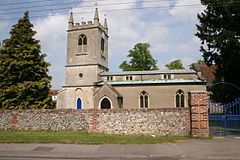Benson, Oxfordshire
| Benson | |
|---|---|
 St Helen's parish church |
|
| Benson shown within Oxfordshire | |
| Area | 9.84 km2 (3.80 sq mi) |
| Population | 4,754 (2011 Census) |
| • Density | 483/km2 (1,250/sq mi) |
| OS grid reference | SU6191 |
| Civil parish |
|
| District | |
| Shire county | |
| Region | |
| Country | England |
| Sovereign state | United Kingdom |
| Post town | Wallingford |
| Postcode district | OX10 |
| Dialling code | 01491 |
| Police | Thames Valley |
| Fire | Oxfordshire |
| Ambulance | South Central |
| EU Parliament | South East England |
| UK Parliament | |
| Website | Benson Parish Council |
Benson is a village and civil parish in South Oxfordshire, England. The 2011 Census recorded the parish's population as 4,754. The village is about 1 1⁄2 miles (2.4 km) north of Wallingford at the foot of the Chiltern Hills at the confluence of a chalk stream (Ewelme Brook) and the River Thames, next to Benson Lock.
Being on the northern (eastern) bank of the Thames, Benson has always been in Oxfordshire, unlike nearby Wallingford and Abingdon, Oxfordshire, which were part of Berkshire until the 1974 boundary changes.
The village is on river silts and gravel, just above the surrounding marshy land that gives nearby settlements of Preston Crowmarsh, Crowmarsh Gifford, and Rokemarsh their names. The fertile land which surrounds the village meant that farming was the main source of employment until the 20th century.
The toponym was originally Villam Regiam, "The King's Town". Later it was Bensington, from the Old English Bænesingtun meaning "farmstead of the people of [a man called] Benesa". The village is reputedly the site of the Battle of Bensington. The present name, Benson, can be found early in the 19th century but Bensington continued in use, at least for formal documents, until well into the second half of the century. The 1866 Working Agreement, made by the GWR for operating the Wallingford and Watlington Railway, used the older form.
There is evidence of human presence dating back to the Palaeolithic period – around 10,000 BC. The village occupies the site of an ancient British town and there is known to have been occupation during the Roman period, although Benson's written history dates back only as far as AD 571.
...
Wikipedia

